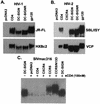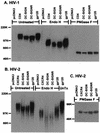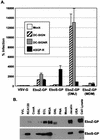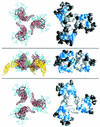Differential N-linked glycosylation of human immunodeficiency virus and Ebola virus envelope glycoproteins modulates interactions with DC-SIGN and DC-SIGNR
- PMID: 12502850
- PMCID: PMC140807
- DOI: 10.1128/jvi.77.2.1337-1346.2003
Differential N-linked glycosylation of human immunodeficiency virus and Ebola virus envelope glycoproteins modulates interactions with DC-SIGN and DC-SIGNR
Abstract
The C-type lectins DC-SIGN and DC-SIGNR [collectively referred to as DC-SIGN(R)] bind and transmit human immunodeficiency virus (HIV) and simian immunodeficiency virus to T cells via the viral envelope glycoprotein (Env). Other viruses containing heavily glycosylated glycoproteins (GPs) fail to interact with DC-SIGN(R), suggesting some degree of specificity in this interaction. We show here that DC-SIGN(R) selectively interact with HIV Env and Ebola virus GPs containing more high-mannose than complex carbohydrate structures. Modulation of N-glycans on Env or GP through production of viruses in different primary cells or in the presence of the mannosidase I inhibitor deoxymannojirimycin dramatically affected DC-SIGN(R) infectivity enhancement. Further, murine leukemia virus, which typically does not interact efficiently with DC-SIGN(R), could do so when produced in the presence of deoxymannojirimycin. We predict that other viruses containing GPs with a large proportion of high-mannose N-glycans will efficiently interact with DC-SIGN(R), whereas those with solely complex N-glycans will not. Thus, the virus-producing cell type is an important factor in dictating both N-glycan status and virus interactions with DC-SIGN(R), which may impact virus tropism and transmissibility in vivo.
Figures








Similar articles
-
The signal peptide of the ebolavirus glycoprotein influences interaction with the cellular lectins DC-SIGN and DC-SIGNR.J Virol. 2006 Jul;80(13):6305-17. doi: 10.1128/JVI.02545-05. J Virol. 2006. PMID: 16775318 Free PMC article.
-
Interactions of LSECtin and DC-SIGN/DC-SIGNR with viral ligands: Differential pH dependence, internalization and virion binding.Virology. 2008 Mar 30;373(1):189-201. doi: 10.1016/j.virol.2007.11.001. Epub 2008 Feb 20. Virology. 2008. PMID: 18083206 Free PMC article.
-
Hepatitis C virus glycoproteins interact with DC-SIGN and DC-SIGNR.J Virol. 2003 Apr;77(7):4070-80. doi: 10.1128/jvi.77.7.4070-4080.2003. J Virol. 2003. PMID: 12634366 Free PMC article.
-
The role of DC-SIGN and DC-SIGNR in HIV and Ebola virus infection: can potential therapeutics block virus transmission and dissemination?Expert Opin Ther Targets. 2002 Aug;6(4):423-31. doi: 10.1517/14728222.6.4.423. Expert Opin Ther Targets. 2002. PMID: 12223058 Review.
-
DC-SIGN: binding receptor for HCV?World J Gastroenterol. 2004 Apr 1;10(7):925-9. doi: 10.3748/wjg.v10.i7.925. World J Gastroenterol. 2004. PMID: 15052667 Free PMC article. Review.
Cited by
-
Neutralization function affected by single amino acid replacement in the HIV-1 antibody targets.Bioinformation. 2015 Feb 28;11(2):57-62. doi: 10.6026/97320630011057. eCollection 2015. Bioinformation. 2015. PMID: 25848164 Free PMC article.
-
Role of glycosphingolipids in dendritic cell-mediated HIV-1 trans-infection.Adv Exp Med Biol. 2013;762:131-53. doi: 10.1007/978-1-4614-4433-6_5. Adv Exp Med Biol. 2013. PMID: 22975874 Free PMC article. Review.
-
Angiodiversity and organotypic functions of sinusoidal endothelial cells.Angiogenesis. 2021 May;24(2):289-310. doi: 10.1007/s10456-021-09780-y. Epub 2021 Mar 21. Angiogenesis. 2021. PMID: 33745018 Free PMC article. Review.
-
The role of antigen-presenting cells in filoviral hemorrhagic fever: gaps in current knowledge.Antiviral Res. 2012 Mar;93(3):416-28. doi: 10.1016/j.antiviral.2012.01.011. Epub 2012 Feb 8. Antiviral Res. 2012. PMID: 22333482 Free PMC article. Review.
-
The signal peptide of the ebolavirus glycoprotein influences interaction with the cellular lectins DC-SIGN and DC-SIGNR.J Virol. 2006 Jul;80(13):6305-17. doi: 10.1128/JVI.02545-05. J Virol. 2006. PMID: 16775318 Free PMC article.
References
-
- Baribaud, F., S. Pöhlmann, T. Sparwasser, M. T. Kimata, Y. K. Choi, B. S. Haggarty, N. Ahmad, T. Macfarlan, T. G. Edwards, G. J. Leslie, J. Arnason, T. A. Reinhart, J. T. Kimata, D. R. Littman, J. A. Hoxie, and R. W. Doms. 2001. Functional and antigenic characterization of human, rhesus macaque, pigtailed macaque, and murine DC-SIGN. J. Virol. 75:10281-10289. - PMC - PubMed
-
- Bashirova, A. A., T. B. Geijtenbeek, G. C. van Duijnhoven, S. J. van Vliet, J. B. Eilering, M. P. Martin, L. Wu, T. D. Martin, N. Viebig, P. A. Knolle, V. N. KewalRamani, Y. van Kooyk, and M. Carrington. 2001. A dendritic cell-specific intercellular adhesion molecule 3-grabbing nonintegrin (DC-SIGN)-related protein is highly expressed on human liver sinusoidal endothelial cells and promotes HIV-1 infection. J. Exp. Med. 193:671-678. - PMC - PubMed
Publication types
MeSH terms
Substances
Grants and funding
LinkOut - more resources
Full Text Sources
Other Literature Sources
Medical
Molecular Biology Databases

